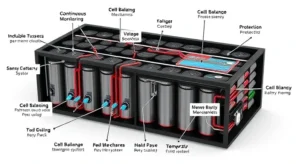Introduction
In today’s tech-driven world, rechargeable batteries power a wide range of devices, from smartphones to electric vehicles (EVs). To maintain the health, safety, and efficiency of these batteries, a Battery Management System (BMS) plays a crucial role. But how does a BMS work, and why is it essential? In this article, we’ll explore how a BMS operates, covering its core components, functionalities, and the role it plays in protecting and enhancing battery performance.
How Does a Battery Management System (BMS) Work?
A Battery Management System (BMS) acts as the “control center” of a battery pack. Its main function is to monitor and manage each cell within the battery to ensure that it operates within safe and optimal parameters. The BMS works through a cycle of continuous monitoring, real-time adjustments, and protective actions that keep the battery healthy, safe, and efficient.
The BMS operates by:
- Monitoring Key Metrics – Voltage, temperature, current, and State of Charge (SoC) are constantly tracked to ensure each cell stays within safe limits.
- Balancing Cells – Cells in a battery pack don’t always charge or discharge at the same rate. A BMS balances the cells to keep them aligned, avoiding overcharge or undercharge situations.
- Controlling Charge and Discharge – By regulating current flow, the BMS prevents issues like overcharging or excessive discharge, which can degrade battery health.
- Communicating with External Systems – In applications like EVs, the BMS relays battery information to display units or other systems, providing real-time data for users.
This cycle of monitoring, balancing, controlling, and communicating forms the core of how a BMS works.
Core Functions of a BMS
A Battery Management System is built around several critical functions that ensure battery health and safety. Let’s dive into these:
- Voltage Monitoring
The BMS constantly checks the voltage levels of each cell in the battery pack. Voltage monitoring is vital because cells should operate within specific voltage limits. Going beyond these limits can damage cells or cause overheating. By monitoring voltage, the BMS ensures that no cell is overcharged or deeply discharged. - Temperature Management
Battery performance and safety are heavily influenced by temperature. High temperatures can accelerate battery aging and increase the risk of thermal runaway (a self-feeding heat reaction), while low temperatures can reduce battery efficiency. The BMS monitors and regulates battery temperature, using cooling systems when needed to prevent overheating. - Current Control
A safe amount of current must flow in and out of the battery during charging and discharging. Excessive current can damage cells or even cause fires. The BMS keeps track of current flow, adjusting it to maintain safe levels and protect the battery. - State of Charge (SoC) Estimation
SoC indicates how much charge remains in the battery, typically shown as a percentage. The BMS calculates SoC to provide users with accurate information about battery life and prevent unexpected shutdowns. This is especially crucial in applications like EVs and smartphones, where users rely on accurate battery information. - State of Health (SoH) Monitoring
SoH is an estimate of the battery’s overall health, reflecting its capacity to hold charge compared to a new battery. The BMS tracks factors like aging and wear to inform users about the condition of their battery over time, highlighting when a replacement might be needed. - Fault Detection and Protection
The BMS provides protection from common issues like overvoltage, undervoltage, overcurrent, and overheating. By detecting these faults, the BMS can shut down the battery or adjust its operation to prevent damage and potential hazards.
Key Components of a BMS
For the BMS to perform these functions, it relies on several key components:
- Battery Cells
Each battery pack is made up of individual cells that provide a certain voltage and capacity. A BMS manages these cells to maximize their performance as a cohesive pack. - Voltage and Current Sensors
These sensors feed real-time voltage and current data to the BMS. This information is crucial for maintaining safe and efficient battery operation. - Temperature Sensors
These sensors monitor cell temperature to prevent overheating and ensure optimal performance, especially under high-demand conditions. - Microcontroller Unit (MCU)
The MCU is the brain of the BMS, processing data from sensors and executing commands to adjust charging, discharging, and other protective actions. - Communication Interface
In applications like EVs, the BMS needs to relay information to external systems (e.g., dashboard displays or control units). Common interfaces include CAN bus, UART, and Bluetooth.
Detailed Breakdown: How a BMS Manages a Battery Pack
- Continuous Monitoring
The BMS monitors critical parameters like voltage, current, temperature, and SoC. This data flows into the MCU, which constantly checks that each cell and the overall pack stay within safe ranges. - Cell Balancing
Batteries are composed of cells that may charge and discharge at different rates. To prevent cells from becoming imbalanced (some fully charged while others are not), the BMS uses either active or passive balancing. Active balancing redistributes charge between cells, while passive balancing discharges cells that have more charge. This ensures a uniform charge level across the battery pack, extending its lifespan. - Protection Mechanisms
The BMS has built-in triggers for unsafe conditions. If a cell overheats or a voltage limit is reached, the BMS can reduce the current, disable charging or discharging, or shut down the battery completely to avoid damage. - Communicating with External Systems
For applications like EVs, the BMS communicates data such as remaining battery life and health status. This information helps users make informed decisions about charging and battery maintenance.
Why BMS is Essential
The BMS is integral to battery operation for several reasons:
- Safety
Batteries, especially lithium-ion, can be sensitive to extreme conditions. A BMS minimizes the risks of accidents like thermal runaway, which can lead to fires. By protecting against overcurrent, overheating, and other faults, a BMS ensures safer battery operation. - Increased Battery Life
A BMS prolongs battery life by maintaining cells within optimal operating conditions. Cell balancing, temperature control, and fault protection all contribute to reducing wear and extending battery lifespan. - Performance Optimization
The BMS ensures consistent power delivery and accurate SoC information, which is crucial for applications that demand high performance, like EVs. - Energy Efficiency
Through effective balancing and thermal management, the BMS improves energy efficiency, maximizing the available power and capacity in each charge cycle.
Applications of Battery Management Systems
BMS technology is utilized across various industries:
- Electric Vehicles (EVs)
In EVs, a BMS ensures battery safety, accurate range estimation, and energy management. It allows EV batteries to handle high-power demands while maximizing lifespan and performance. - Renewable Energy Storage
In systems that store solar or wind energy, BMS maintains battery health amid frequent charge and discharge cycles, protecting against environmental fluctuations. - Consumer Electronics
BMS technology is used in smartphones, laptops, and tablets to ensure safety, battery life, and accurate charge display. - Industrial Equipment
Heavy-duty batteries in forklifts, backup power supplies, and other machinery rely on BMS to ensure stable operation and quick error detection.
Types of Battery Management Systems
There are different types of BMS configurations based on the system’s size and requirements:
- Centralized BMS
In a centralized setup, all battery data flows to a single controller. This type is simpler but can become challenging to manage with large battery packs. - Modular BMS
A modular BMS has multiple controllers, each managing sections of the battery pack, making it more scalable and flexible for larger systems. - Distributed BMS
Each cell or group of cells has its own controller, allowing high accuracy and fault tolerance but increasing the overall cost.
Conclusion
A Battery Management System (BMS) is the backbone of any rechargeable battery pack, ensuring safe, efficient, and long-lasting operation. From monitoring individual cells to preventing potential hazards, the BMS operates as the control center, enabling batteries to perform at their best. As battery technology continues to advance, the role of BMS will only grow, becoming essential in high-power applications like electric vehicles and renewable energy. Whether for personal devices or industrial equipment, a BMS is key to powering our future safely and sustainably.








